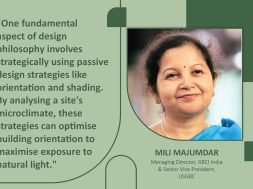Exploring the node of green designs and aesthetics

In design philosophy, passive design strategies, with orientation and shading as pivotal elements, offer a pathway towards optimised energy efficiency.
How do you incorporate passive design strategies, such as orientation and shading, to optimise energy efficiency in your building projects?
One fundamental aspect of design philosophy is passive design strategies such as orientation and shading. By analysing the microclimate of a site, one can optimise building orientation to maximise exposure to natural light. Shading elements, such as overhangs and louvres, are meticulously integrated to balance heat and light, contributing significantly to energy efficiency. USGBC and GBCI’s certification processes emphasise passive design strategies during the design and planning stages. Projects that align with these strategies earn points toward certification, encouraging the industry to adopt energy-efficient design principles. Beyond certification, we actively engage in educational initiatives to promote awareness of passive design benefits. Workshops, webinars, and publications disseminate knowledge on optimising building orientation and shading to enhance energy efficiency across diverse projects.
How do you address the balance between energy efficiency and aesthetic considerations in your architectural designs?
I always believe that sustainable design should maintain visual appeal. Our LEED (Leadership in Energy and Environmental Design) rating systems incorporate aesthetic considerations alongside energy efficiency. By acknowledging the importance of both aspects, we guide projects to strike a balance through sustainable design elements. This approach allows architects and designers to make informed choices that contribute to the overall success of a project. We also support research on how buildings can have aesthetics while using energy-efficient products or designs. Collaborations with academic institutions and industry experts generate valuable insights and a deeper understanding of how design choices impact visual appeal and energy performance.

Can you describe your approach to optimising natural lighting in buildings to minimise the need for artificial lighting and enhance energy efficiency?
Our approach to natural lighting optimisation prioritises human-centric design. By focusing on occupant well-being and productivity, we encourage projects to leverage natural light effectively, minimising reliance on artificial lighting and enhancing overall energy efficiency. Certification criteria include performance metrics for natural lighting. Projects that optimise daylight usage earn recognition, reinforcing the importance of this design aspect in our pursuit of sustainable built environments.
How do you approach selecting energy-efficient materials and technologies in your projects, considering both environmental impact and long-term energy savings?
We guide the industry towards selecting materials with lower environmental impact. While not prescribing specific choices, our emphasis on sustainable material criteria encourages responsible selection. We highlight projects that use innovative technologies to improve energy efficiency. This approach motivates the industry to explore and adopt cutting-edge solutions without imposing rigid technology preferences.
What design strategies and technologies do you prioritise in net zero projects to achieve energy neutrality and reduce environmental impact?
We have clear guidelines for integrating renewable energy sources for projects aspiring to achieve net-zero status. This commitment aligns with our overarching goal of promoting environmentally responsible practices. Projects demonstrating ongoing commitment to energy efficiency measures earn commendation, promoting a culture of innovation and sustainability.
For more details visit: https://www.gbci.org/india
23
Cookie Consent
We use cookies to personalize your experience. By continuing to visit this website you agree to our Terms & Conditions, Privacy Policy and Cookie Policy.







